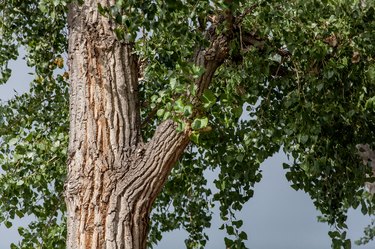
If you have a cottonwood tree (Populus spp.) or want to plant one, then you may already know that a cottonwood becomes dormant in winter and is dioecious, which means each tree is either male or female. Cottonwood is also large, fast-growing and available in several varieties. The tree grows well when given basic care, although also paying attention to several possible problems is essential.
Water Guidelines
Video of the Day
Cottonwood varieties include the black cottonwood (Populus trichocarpa), which can become 100 feet tall and is hardy in U.S. Department of Agriculture plant hardiness zones 5 through 9. Most cottonwoods grow best in evenly moist soil. So water any kind of cottonwood's soil as needed to prevent it from drying out. Check the soil's moisture level by using a small shovel to make a narrow, 2-inch-deep trench in the soil. If the trench's soil feels dry to your touch, then water the tree's soil deeply but slowly to ensure the water reaches all the roots. Applying a 3- to 4-inch-thick layer of straw or shredded bark on the ground under the tree's canopy will retain soil moisture, but keep that mulch several inches from the cottonwood's trunk to discourage fungal problems.
Video of the Day
Fertilizer Application
An established cottonwood tree doesn't need fertilizer on a regular basis; fertilizer can cause too much soft, tender growth that damages easily. If, however, your tree is young, or if an older tree's growth slows and the leaves are small, then you can support the cottonwood by fertilizing its soil in spring when the tree begins new growth. Apply a granular, 16-4-8 fertilizer to the tree's root zone, using 12 1/2 pounds for every 1,000 square feet of the tree's root zone. The root zone is the area under the tree that is equal to 1 1/2 times the diameter of the tree's canopy -- or a circular area that is 18 feet wide for a tree with a 12-foot-wide canopy. Scratch the fertilizer into the soil, distributing it evenly, and water the fertilized area well.
Removal of Sprouts and Damaged Branches
Cottonwoods include the eastern cottonwood (Populus deltoides), which is hardy in USDA zones 2 through 9. It and most other cottonwoods have a rounded crown and open growth habit, and they don't require regular pruning to develop a visually pleasing shape. Cottonwood twigs that stick into the soil under the tree, though, can develop roots and sprout, producing unwanted growth at ground level. Remove those sprouts by cutting them to the ground, using sharp pruning shears and wiping the blades with rubbing alcohol before each cut to discourage the spread of plant diseases; disinfect the blades in the same way when you finish using them. Ensure the sprouts don't reappear by using a small shovel to remove all the roots that grew from each twig. All cottonwoods have branches that tend to be weak and susceptible to wind damage. Remove split or otherwise damaged branches as they appear, using loping pruners or a pruning saw for large branches, and disinfecting the pruning tool before each cut and after you finish using it.
Potential Problems
Cottonwood is susceptible to several fungal disorders, including rusts and leaf spot. The best ways to prevent those problems are to water the tree at its base, avoiding wetting its foliage, and to water on only sunny days so surfaces that become wet dry quickly. Clearing debris from under the tree on a regular basis also helps prevent fungal problems.
Cottonwood can attract aphids, which are small, greenish-yellow, soft-bodied pests. Destroy them by spraying the tree until all its surfaces are wet with insecticidal soap, diluted at a rate of 5 tablespoons of insecticidal soap concentrate per 1 gallon of water; use the solution when the temperature is below 90 degrees Fahrenheit. Repeat the spray application every seven to 10 days as needed. Scale insects, which look like hard, dark spots on leaves and stems, also may attack a cottonwood. When you see scale insects on your tree, spray all its surfaces until they are wet with a horticultural oil that you diluted at a rate of 5 tablespoons per 1 gallon of water; use the solution only when the temperature is below 90 degrees Fahrenheit and when drought is not an issue. When mixing or using insecticidal soap, horticultural oil or a solution made from either product, wear a hat, goggles and clothing that covers your skin, and avoid breathing the fumes and spray mist.
- Clemson Cooperative Extension: Fertilizing Trees and Shrubs
- North Dakota State University Extension Service: Questions on Cottonwood
- Missouri Botanical Garden: Populus Deltoides
- Arbor Day Foundation: Tree Watering
- California Polytechnic State University, Urban Forest Ecosystems Institute: Black Cottonwood